
Are is a monotypic moth genus in the subfamily Arctiinae erected by Francis Walker in 1855. The type species is Are druryi, which is found on Jamaica. This species was described by Dru Drury in 1773 under the name Phalaena marginata, but this name is preoccupied by Phalaena marginataLinnaeus, 1758 and a new specific epithet, honouring Drury, was assigned in 1986.
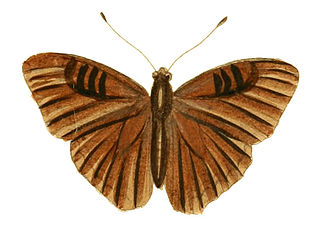
Euriphene doriclea, the Doriclea nymph, is a butterfly in the family Nymphalidae. It is found in Sierra Leone, Liberia, Ivory Coast, Ghana, Nigeria, Cameroon, Gabon, the Central African Republic, the Democratic Republic of the Congo and Uganda. The habitat consists of forests.

Euphaedra perseis, the Perseis mimic forester, is a butterfly in the family Nymphalidae. It is found in Guinea (Conakry), Sierra Leone, Liberia, Ivory Coast and western Ghana. It was first described by Dru Drury in 1773.

Euphaedra eupalus, the western blue-banded forester, is a butterfly in the family Nymphalidae. It is found in Guinea, Sierra Leone, Liberia, Ivory Coast, Ghana and Togo.
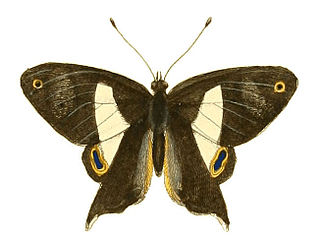
Abisara gerontes, the dark banded Judy, is a butterfly in the family Riodinidae. It is found in Sierra Leone, Liberia, Ivory Coast, Ghana, Nigeria, Cameroon, Gabon, the Republic of the Congo and the Democratic Republic of the Congo. The habitat consists of tropical humid forests and lowland forests in hilly terrain.
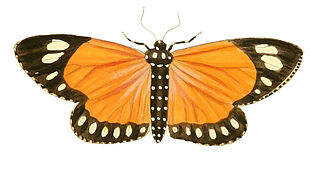
Scopula helcita is a moth of the family Geometridae first described by Carl Linnaeus in his 1763 Centuria Insectorum. It is found in Cameroon, the Republic of the Congo, the Democratic Republic of the Congo, Equatorial Guinea, Ghana, Nigeria, Sierra Leone, South Africa and Uganda.
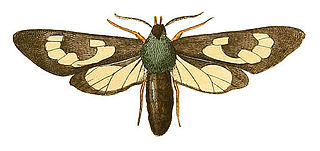
Cosmosoma fenestrata is a moth of the family Erebidae. It was described by Dru Drury in 1773. It is found on Jamaica and Cuba.

Episcepsis thetis is a moth of the family Erebidae. It was described by Carl Linnaeus in 1771. It is found in Panama and Venezuela.
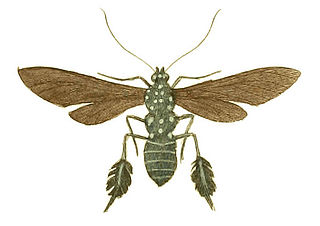
Horama plumipes is a moth of the subfamily Arctiinae. It was described by Dru Drury in 1773. It is found in southern Texas, Mexico, Honduras, Belize, Guatemala and Nicaragua.

Hypocrita pylotis is a moth of the family Erebidae. It was described by Dru Drury in 1773. It is found in Honduras.

Amata cerbera, the heady maiden, is a moth of the subfamily Arctiinae. It was described by Carl Linnaeus in 1764. It has an extensive range in sub-Saharan Africa.
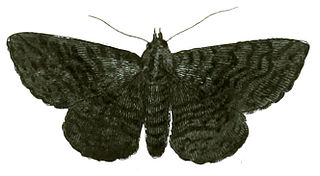
Zale undularis, the black zale moth, is a moth of the family Noctuidae. The species was first described by Dru Drury in 1773. It is found in the eastern United States and southern Ontario.
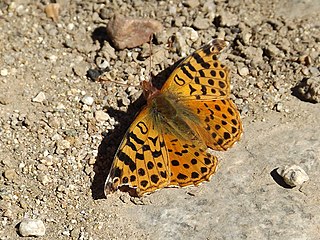
Yramea cytheris is a species of butterfly in the family Nymphalidae. It was first described by Dru Drury in 1773 from the Falkland Islands. In some systems it is included in genus Issoria.

Greta diaphanus, the Antillean clearwing, is a species of clearwing (ithomiine) butterflies, named by Dru Drury in 1773.

Otroeda cafra is a species of moth in the tussock-moth subfamily Lymantriinae. It was first described by Dru Drury in 1782 from Sierra Leone, and is also found in Cameroon, DR Congo, Malawi, and Nigeria.

Otroeda nerina is a species of moth in the tussock-moth subfamily Lymantriinae. It was first described by Dru Drury in 1782 from Sierra Leone, and is also found in Cameroon, DR Congo, Gabon, Ghana and Nigeria.
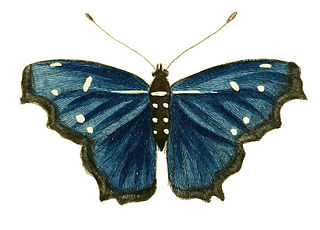
Myscelia orsis is a species of nymphalid butterflies native to Brazil. It was first described by Dru Drury in 1782.

Pierella nereis is a butterfly species from the subfamily Satyrinae in the family Nymphalidae. It was first described by Dru Drury in 1782 from Brazil.
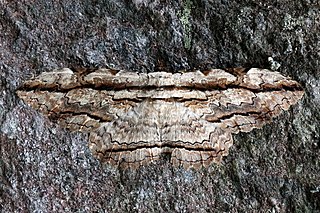
Thysania zenobia, the owl moth, is a species of moth in the family Erebidae. The species was first described by Pieter Cramer in 1776, and is native to North and South America and the Caribbean.

Lyssa patroclus is a species of moth in the family Uraniidae. The species was described by Carl Linnaeus in his 1758 10th edition of Systema Naturae from the Moluccas.



















